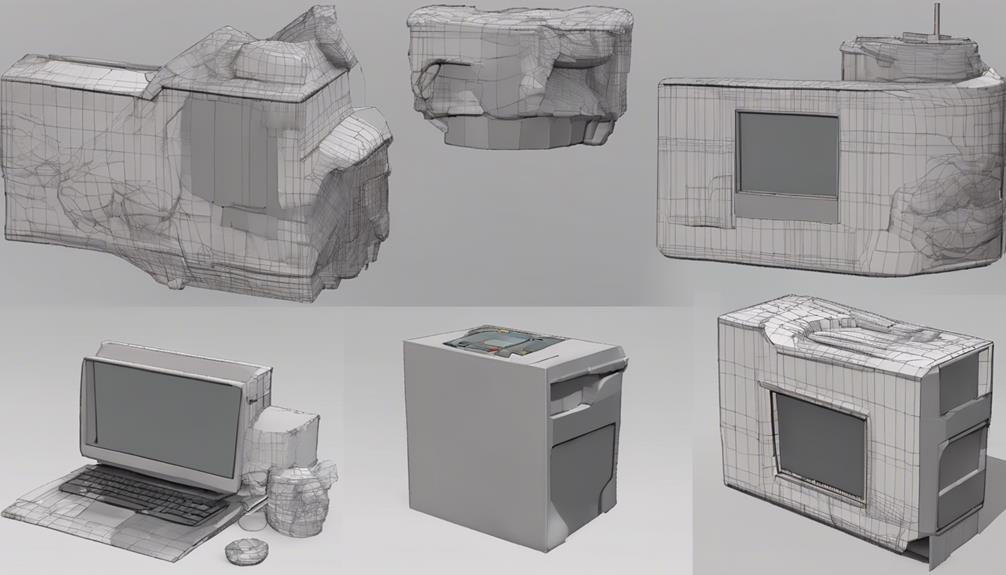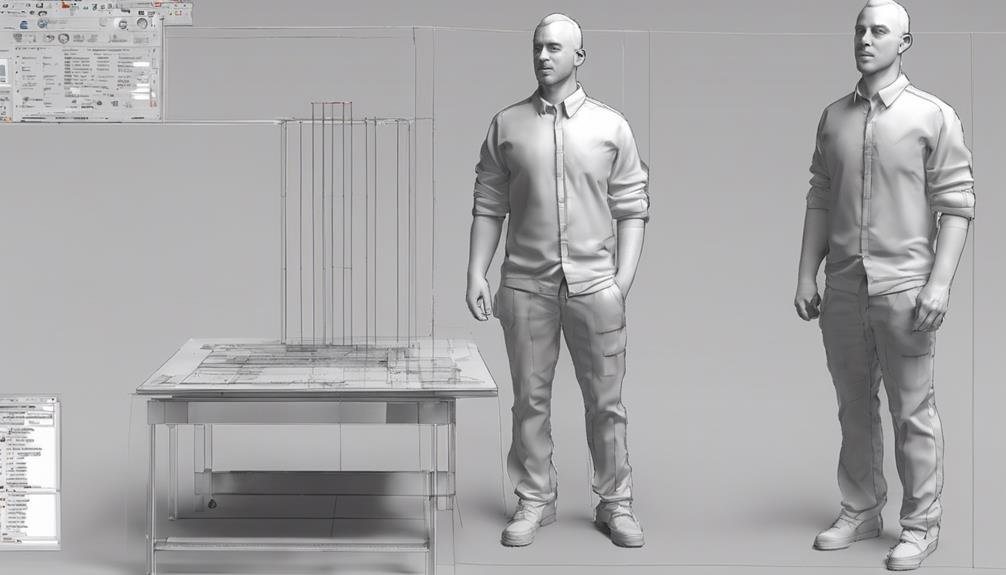When utilizing SketchUp for 3D printing, make sure models are solid and error-free. Design solid objects, verify printability with tools like Solid Inspector 2, and export in STL format for compatibility. Organize geometry into groups and check solidity using Entity Info for accuracy. Address model issues with Solid Inspector 2 and inspect volume and face orientation. Utilize SketchUp features like X-Ray Mode for checking and export models with proper settings. Airtight models with no gaps guarantee successful prints. Improperly prepared models may lead to print failures.
Sketchup Compatibility With 3D Printing
SketchUp's compatibility with 3D printing simplifies the process of creating and preparing models for successful printing. When you design a model in SketchUp for 3D printing, ensuring it's a solid, watertight model is important for a flawless print. By utilizing features like Solid Inspector and extensions such as SketchUp STL Exporter, you can efficiently check and correct any issues with your model before exporting it in the STL format. This format is widely supported by different 3D printing software and hardware, ensuring seamless compatibility.
Exporting STL files from SketchUp allows you to retain the intricate details of your model, including faces and geometric shapes, necessary for a high-quality print. The solid modeling capabilities in SketchUp guarantee that your model is error-free and ready for 3D printing, reducing the chances of printing failures.
This compatibility between SketchUp and 3D printing technologies like MakerBot improves your printing experience, making it accessible and efficient for both beginners and professionals alike.
Creating 3D Models in SketchUp
To create 3D models in SketchUp for successful printing, it's important to design them as solid objects and utilize tools like Solid Inspector 2 for confirming printability.
When creating your SketchUp model, make sure all faces point outward, forming a solid group. Use the 'Make Group' function to enclose your design properly. This step is vital for 3D printing as it guarantees that the model is airtight and suitable for the printing process.
SketchUp offers the option to export your model in the STL format commonly used by 3D printers. Before sending your model to a printing service, it's necessary to check the exported STL file using tools like Solid Inspector 2 to fix any potential issues.
Exporting Models for 3D Printing

Consider exporting your SketchUp models in the STL format for best compatibility with slicer software and 3D printers. This format ensures that your designs can be accurately interpreted by the printing software, leading to successful prints.
Before exporting, check the STL files to guarantee completeness; any gaps or missing geometry may compromise the print quality. To streamline the process, utilize free or Trimble-signed SketchUp extensions like SimLab STL Exporter or SketchUp STL. These extensions not only simplify exporting but also help optimize your models for printing.
It's important to make sure your models are solid, without any internal cavities, and have appropriate wall thickness to prevent printing issues. By using these SketchUp extensions and verifying the solidity of your models, you pave the way for successful 3D prints with high-quality results.
Install the necessary extensions for easy access to the Export STL option in the File menu, making the export process straightforward and efficient.
Ensuring Model Solidness in SketchUp
Check your SketchUp models' solidity by ensuring all geometry is appropriately grouped or componentized. When preparing models for 3D printing, the model solidity is vital to avoid printing issues.
Start by organizing your design into distinct groups or components to prevent overlapping geometry. Use the Entity Info window in SketchUp to verify that all elements are recognized as solid objects.
For a more thorough check, employ the Solid Inspector2 extension, which can detect and help you rectify any gaps, holes, or other flaws that may compromise the model's solidity.
Remember, a solid model without overlapping geometry is essential for obtaining accurate 3D prints. Ensuring proper geometry grouping and addressing any discrepancies will improve the chances of your design translating seamlessly into a physical object.
Tools for 3D Printing Preparation

Guarantee smooth 3D printing preparation by leveraging a variety of tools available in SketchUp.
- Solid Inspector 2: Use this extension to identify and fix model solidity issues, internal geometry problems, and holes, ensuring your model is ready for 3D printing.
- Face Orientation: Check faces to confirm they point outward, aiding in correct printing orientation. Use tools like Monochrome view for clarity in identifying any issues.
- Model Volume: Verify model volume by checking thickness and ensuring readiness for printing. Confirm that hollow models have the required volume for successful printing.
- Export Models: Export your models in STL format from SketchUp, adjusting settings like Swap YZ Coordinates and unit selection to match your 3D printer requirements.
- SketchUp Tools: Utilize features like X-Ray Mode, Hide, and Monochrome view for detailed inspection, orientation correction, and model optimization before proceeding with 3D printing.
Tips for Successful 3D Printing
For successful 3D printing, prioritize making sure your models are designed with solid and watertight structures to avoid potential printing complications.
Check the wall thickness of your models to prevent fragile or unprintable parts.
Address reversed faces and overlapping geometry to guarantee accurate prints.
When using SketchUp, utilize high-quality STL export settings to optimize printing results.
Creating solid models is essential, as any gaps or holes can lead to printing errors. Make certain that your designs are watertight, meaning there are no gaps where material could leak out during printing.
Overlapping geometry can cause issues, so ensure all parts are correctly aligned.
Regularly inspect and optimize your models to secure successful 3D printing outcomes.
Frequently Asked Questions
Is Sketchup Any Good for 3D Printing?
SketchUp is great for 3D printing. It simplifies design with solid tools and STL export. Consider printing limits, material, support, and scaling. Check layers, quality, and use different filaments. Its compatibility improves your printing experience.
Is Sketchup Good for 3D Modelling?
SketchUp features robust modeling capabilities, customizable tools, and precise design software. Its user-friendly interface simplifies the process, making it suitable for both beginners and professionals. Export options and print settings cater to 3D printing compatibility.
Can Sketchup Make 3D Models?
Yes, SketchUp can create 3D models, but it involves design challenges and a learning curve. Make sure models are solid objects for 3D printing compatibility. Export as STL files, take into account precision requirements, material options, and support structures.
How to Print a Model in Sketchup?
Prepare your model in SketchUp for printing by ensuring it's a solid group, checking face orientation, and confirming volume. Export in STL format for printer compatibility. Use tools like Solid Inspector 2 for solidity.
Conclusion
To sum up, SketchUp is a versatile tool that can be used for creating 3D models for 3D printing. By ensuring model solidness, exporting models correctly, and utilizing the right tools for preparation, you can successfully bring your designs to life.
Remember to follow the tips provided for a smooth printing process. With attention to detail and proper preparation, SketchUp can be a valuable asset in your 3D printing projects.